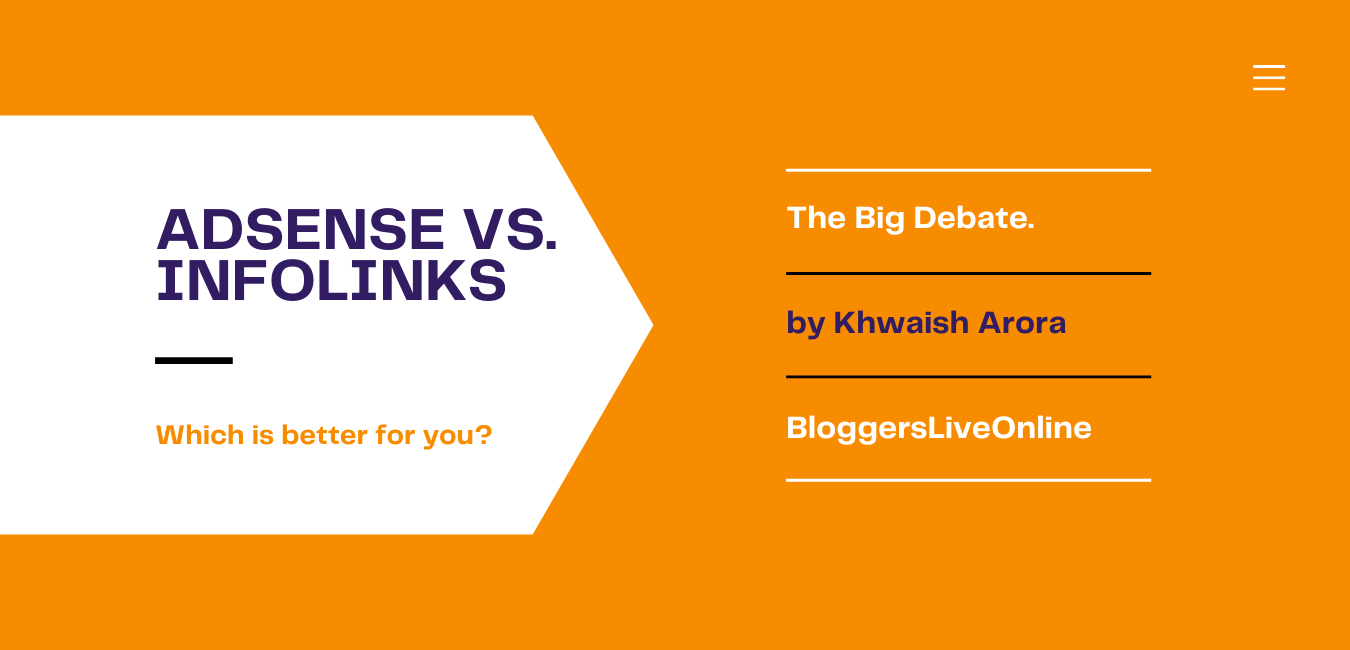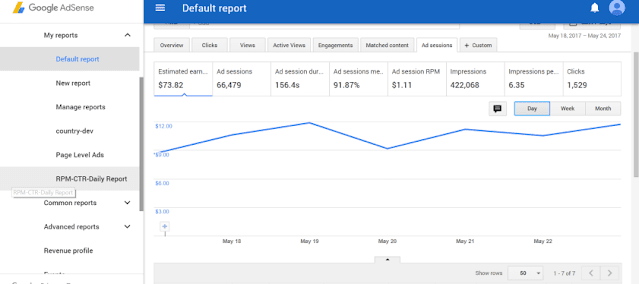AdSense VS. Infolinks - The Big Debate. Which is better for you?
Some prefer text ads, some prefer display ads, while some find pop-under ads the least invasive of all. Different advertising networks have come up to help advertisers convey brand information using different ad units that are showcased on publisher websites; in return, publishers gain high revenues.
Equipped with an easy setup procedure, user-friendly interface, impressive revenues, and timely payments, Google AdSense is currently the largest and most sought-after ad network. It is a contextual ad network that specializes in banner advertising and also provides other display ad units.
Infolinks is a distinctive contextual ad network that seeks to provide an alternative to traditional display advertising in order to tackle the end user’s banner blindness.
This is the reason that the network does not deliver too many banner ads. Infolinks is considered to be the 6th largest advertising network. In this article, we will do a comparative study of these two ad networks and try to understand which one would be a better fit for the monetization of your website or blog.
AdSense offers 68% revenue to publishers who display content advertisements. However, publisher revenue share drops down to 51% if the ad platform is primarily used on the search platform. Google keeps the rest as an acknowledgment of the services rendered.
Google AdSense delivers very high-quality ads of all its brand advertisers across all its publishing networks. This is a huge factor that makes it hard to beat the network. AdSense has a number of ad formats like text ads, image-rich ads, matched content ads, video ads, etc. The banner ads and video ads delivered by AdSense are particularly eye-catching.
AdSense has an unrivaled worldwide reach and is used by everyone ranging from large companies, medium-sized businesses to small-time users. Mashable, Times Network, and HubPages are a few of its top publishers.
AdSense follows a monthly payment schedule. It pays publishers through a number of modes such as transfer through cheque, Western Union, EFT, and Rapida. The minimum payout threshold of AdSense is $10. AdSense provides detailed reports about an ad campaign in real-time.
Infolinks vs AdSense: Minimum Traffic Requirement
There is no minimum traffic requirement for becoming a publisher in the Infolinks network. The network accepts websites in any language. It does not grant approval to websites that have adult content and content related to hatred or violence. The signup and implementation process in this network are very easy.Google AdSense does not have a minimum traffic requirement for publisher websites. The one mandatory requirement is that the website or blog keeps posting quality content related to the advertisements posted on its pages.
The network accepts sites in all languages supported by Google. You can check this link here for the list of AdSense supported languages.
Infolinks vs AdSense: Revenue Share Percentage
Infolinks offers 70% of the generated revenue to the publishers. The network has a referral program. Through the program, if a publisher signs up using an existing publisher’s referral link, the existing publisher can earn 10% of the former’s revenue for a year.AdSense offers 68% revenue to publishers who display content advertisements. However, publisher revenue share drops down to 51% if the ad platform is primarily used on the search platform. Google keeps the rest as an acknowledgment of the services rendered.
Infolinks vs AdSense: Ad Quality
Even though the ad quality in the Infolinks network is standard, the ad relevancy is very poor due to a comparatively low-quality keyword scanning algorithm. It offers mainly 4 ad units – in Text ads, in Frame ads, in Search ads, and in Tag ads. The network mainly focuses on textual ads as those look more organic and blend with the website content more easily.Google AdSense delivers very high-quality ads of all its brand advertisers across all its publishing networks. This is a huge factor that makes it hard to beat the network. AdSense has a number of ad formats like text ads, image-rich ads, matched content ads, video ads, etc. The banner ads and video ads delivered by AdSense are particularly eye-catching.
Infolinks vs AdSense: Publisher List
The Infolinks network does not have a very strong publisher base as the revenues generated can be quite low due to a number of factors. However, the network can monetize tier one traffic, mainly US and Canadian traffic.AdSense has an unrivaled worldwide reach and is used by everyone ranging from large companies, medium-sized businesses to small-time users. Mashable, Times Network, and HubPages are a few of its top publishers.
Infolinks vs AdSense: CPM and RPM Rates
The Click-through Rate (CTR) is on the higher side most of the time as the ads are placed on the website content. CPM and CPC offered for European and American traffic are much more than what is offered for Asian traffic. The CPM rate is in the range of USD 1 to 5 for every 1000 ad impressions. RPM is found to be between USD 1.5 to 4.
The rates are variable as publishers can decide their rates per view. Infolinks, however, have very low CPM rates for Indian traffic and thus are only recommended to publishers who have very high traffic volume. Additionally, using the wallpaper ads from Infolinks can increase your overall revenue. Infolinks does provide a number of ad formats that publishers can use to increase their overall ad revenue.
Adsense offers CPM rates in the range of USD 1 to 3. The average AdSense ad RPM lies in the range of USD 5 to 10 for broad niches. In the case of competitive niches with greater CPC, the rate is around much higher and can even reach USD 50 and above on page RPM. AdSense has a fill rate of 100%.
Adsense offers CPM rates in the range of USD 1 to 3. The average AdSense ad RPM lies in the range of USD 5 to 10 for broad niches. In the case of competitive niches with greater CPC, the rate is around much higher and can even reach USD 50 and above on page RPM. AdSense has a fill rate of 100%.
However, publishers can now block low-paying ads and still earn good revenue from AdSense using the Ad quality filter available in the AdSense dashboard.
Infolinks vs AdSense: Payments and Earnings Report
Infolinks pays publishers on a NET 45 basis and the minimum payout threshold is $50. The available modes of payment are PayPal, wire transfer, eCheck, Western Union, ACH, Payoneer. Recently, they have come across a number of innovative ad formats for publishers. These formats can be enabled from the dashboard with one click.READ - How To Place Google AdSense Ads Between Blogger Posts
AdSense follows a monthly payment schedule. It pays publishers through a number of modes such as transfer through cheque, Western Union, EFT, and Rapida. The minimum payout threshold of AdSense is $10. AdSense provides detailed reports about an ad campaign in real-time.
Verdict
There is no doubt about the impeccable services provided by AdSense; it truly lives up to its reputation. It provides a robust keyword scanning algorithm, high-quality ads, flexible ad controls, and some of the highest payments.Getting accepted by AdSense is almost like a global stamp of validation. But AdSense falters when it comes to the approval process. It can take up to a few months to gain access to AdSense, particularly in non-US countries. Also, it imposes a lot of restrictions on the publishers with respect to the content on the site, which can be a bit obtrusive.
This is why publishers sometimes look for AdSense alternatives. Infolinks is quite a unique network that manages to combat the banner blindness of a lot of end-users. But its ad relevancy is very poor, the reason why there are not a lot of quality advertisers on board. Thus it fails to generate high revenues. The CPM rates offered are quite low.
This is why publishers sometimes look for AdSense alternatives. Infolinks is quite a unique network that manages to combat the banner blindness of a lot of end-users. But its ad relevancy is very poor, the reason why there are not a lot of quality advertisers on board. Thus it fails to generate high revenues. The CPM rates offered are quite low.
So Infolinks is best suited for sites with high traffic. If a publisher is looking for an alternative to traditional display advertising, Infolinks is definitely worth a try.
Infolinks can be run in conjugation with affiliate networks such as Chitika and AdSense.
On a general note, InfoLinks is getting popular due to its quick approval rate and higher payouts whereas Google Adsense is becoming a lot more stringent, and getting your account activated is a project in itself. However, there are well-known reasons for this strict approach and Infolinks will learn their lessons too. Adsense has the power of Google and hence gives more visibility though.
It can be a reasonable network to help support the earnings from Google AdSense. But it needs to work hard on its keyword scanning algorithm. We hope this discussion has been helpful to you and will enable you to make a decision.







Comments
Post a Comment